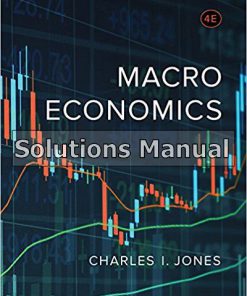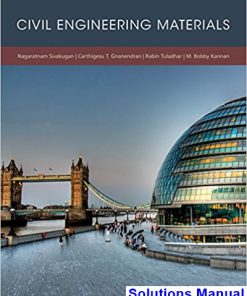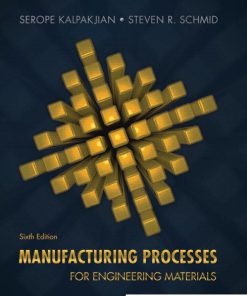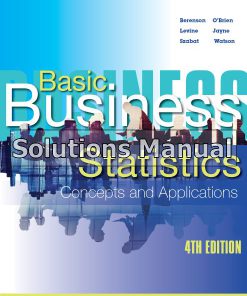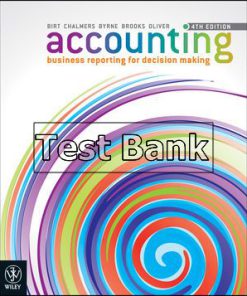Engineering Materials 1 4th Edition Jones Solutions Manual
You may also like
This is completed downloadable of Engineering Materials 1 4th Edition Jones Solutions Manual

Product Details:
- ISBN-10 : 0080966659
- ISBN-13 : 978-0080966656
- Author:
Widely adopted around the world, Engineering Materials 1 is a core materials science and engineering text for third- and fourth-year undergraduate students; it provides a broad introduction to the mechanical and environmental properties of materials used in a wide range of engineering applications. The text is deliberately concise, with each chapter designed to cover the content of one lecture. As in previous editions, chapters are arranged in groups dealing with particular classes of properties, each group covering property definitions, measurement, underlying principles, and materials selection techniques. Every group concludes with a chapter of case studies that demonstrate practical engineering problems involving materials.
Engineering Materials 1, Fourth Edition is perfect as a stand-alone text for a one-semester course in engineering materials or a first text with its companion Engineering Materials 2: An Introduction to Microstructures and Processing, in a two-semester course or sequence.
Table of Content:
Chapter 1. Engineering Materials and Their Properties
1.1. Introduction
1.2. Examples of Materials Selection
Chapter 2. The Price and Availability of Materials
2.1. Introduction
2.2. Data for material prices
2.3. The use-pattern of materials
2.4. Ubiquitous materials
2.5. Exponential growth and consumption doubling-time
2.6. Resource availability
2.7. The future
2.8. Conclusion
Chapter 3. The Elastic Moduli
3.1. Introduction
3.2. Definition of Stress
3.3. Definition of Strain
3.4. Hooke’s Law
3.5. Measurement of Young’s Modulus
3.6. Data for Young’s Modulus
Chapter 4. Bonding between Atoms
4.1. Introduction
4.2. Primary bonds
4.3. Secondary bonds
4.4. The condensed states of matter
4.5. Interatomic forces
Chapter 5. Packing of Atoms in Solids
5.1. Introduction
5.2. Atom Packing in Crystals
5.3. Close-Packed Structures and Crystal Energies
5.4. Crystallography
5.5. Plane Indices
5.6. Direction Indices
5.7. Other Simple Important Crystal Structures
5.8. Atom Packing in Polymers
5.9. Atom Packing in Inorganic Glasses
5.10. The Density of Solids
Chapter 6. The Physical Basis of Young’s Modulus
6.1. Introduction
6.2. Moduli of Crystals
6.3. Rubbers and the Glass Transition Temperature
6.4. Composites
Chapter 7. Case Studies in Modulus-Limited Design
7.1. Case Study 1: Selecting Materials for Racing Yacht Masts
7.2. Case Study 2: Designing a Mirror for a Large Reflecting Telescope
7.3. Case Study 3: The Challenger Space Shuttle Disaster
Chapter 8. Yield Strength, Tensile Strength, and Ductility
8.1. Introduction
8.2. Linear and Nonlinear Elasticity
8.3. Load–Extension Curves for Nonelastic (Plastic) Behavior
8.4. True Stress–Strain Curves for Plastic Flow
8.5. Plastic Work
8.6. Tensile Testing
8.7. Data
8.8. A Note on the Hardness Test
Chapter 9. Dislocations and Yielding in Crystals
9.1. Introduction
9.2. The Strength of a Perfect Crystal
9.3. Dislocations in Crystals
9.4. The Force Acting on a Dislocation
9.5. Other Properties of Dislocations
Chapter 10. Strengthening Methods and Plasticity of Polycrystals
10.1. Introduction
10.2. Strengthening Mechanisms
10.3. Solid Solution Hardening
10.4. Precipitate and Dispersion Strengthening
10.5. Work-Hardening
10.6. The Dislocation Yield Strength
10.7. Yield in Polycrystals
10.8. Final Remarks
Chapter 11. Continuum Aspects of Plastic Flow
11.1. Introduction
11.2. The onset of yielding and the shear yield strength, k
11.3. Analyzing the hardness test
11.4. Plastic instability: necking in tensile loading
Chapter 12. Case Studies in Yield-Limited Design
12.1. Introduction
12.2. Case Study 1: Elastic Design—Materials for Springs
12.3. Case Study 2: Plastic Design—Materials for Pressure Vessels
12.4. Case Study 3: Large-Strain Plasticity—Metal Rolling
Chapter 13. Fast Fracture and Toughness
13.1. Introduction
13.2. Energy Criterion for Fast Fracture
13.3. Data for Gc and Kc
Chapter 14. Micromechanisms of Fast Fracture
14.1. Introduction
14.2. Mechanisms of Crack Propagation 1: Ductile Tearing
14.3. Mechanisms of Crack Propagation 2: Cleavage
14.4. Composites, Including Wood
14.5. Avoiding Brittle Alloys
Chapter 15. Probabilistic Fracture of Brittle Materials
15.1. Introduction
15.2. The Statistics of Strength
15.3. The Weibull Distribution
15.4. The Modulus of Rupture
Chapter 16. Case Studies in Fracture
16.1. Introduction
16.2. Case Study 1: Fast Fracture of an Ammonia Tank
16.3. Case Study 2: Explosion of a Perspex Pressure Window during Hydrostatic Testing
16.4. Case Study 3: Cracking of a Foam Jacket on a Liquid Methane Tank
Chapter 17. Fatigue Failure
17.1. Introduction
17.2. Fatigue of Uncracked Components
17.3. Fatigue of Cracked Components
17.4. Fatigue Mechanisms
Chapter 18. Fatigue Design
18.1. Introduction
18.2. Fatigue Data for Uncracked Components
18.3. Stress Concentrations
18.4. The Notch Sensitivity Factor
18.5. Fatigue Data for Welded Joints
18.6. Fatigue Improvement Techniques
18.7. Designing Out Fatigue Cycles
Chapter 19. Case Studies in Fatigue Failure
19.1. Case Study 1: The Comet Air Disasters
19.2. Case Study 2: The Eschede Railway Disaster
19.3. Case Study 3: The Safety of the Stretham Engine
Chapter 20. Creep and Creep Fracture
20.1. Introduction
20.2. Creep Testing and Creep Curves
20.3. Creep Relaxation
20.4. Creep Damage and Creep Fracture
20.5. Creep-Resistant Materials
Chapter 21. Kinetic Theory of Diffusion
21.1. Introduction
21.2. Diffusion and Fick’s Law
21.3. Data for Diffusion Coefficients
21.4. Mechanisms of Diffusion
Chapter 22. Mechanisms of Creep, and Creep-Resistant Materials
22.1. Introduction
22.2. Creep Mechanisms: Metals and Ceramics
22.3. Creep Mechanisms: Polymers
22.4. Selecting Materials to Resist Creep
Chapter 23. The Turbine Blade—A Case Study in Creep-Limited Design
23.1. Introduction
23.2. Properties Required of a Turbine Blade
23.3. Nickel-Based Super-Alloys
23.4. Engineering Developments—Blade Cooling
23.5. Future Developments: High-Temperature Ceramics
23.6. Cost Effectiveness
Chapter 24. Oxidation of Materials
24.1. Introduction
24.2. The Energy of Oxidation
24.3. Rates of Oxidation
24.4. Data
24.5. Micromechanisms
Chapter 25. Case Studies in Dry Oxidation
25.1. Introduction
25.2. Case Study 1: Making Stainless Alloys
25.3. Case Study 2: Protecting Turbine Blades
25.4. A Note on Joining Operations
Chapter 26. Wet Corrosion of Materials
26.1. Introduction
26.2. Wet Corrosion
26.3. Voltage Differences as the Driving Force for Wet Oxidation
26.4. Pourbaix (Electrochemical Equilibrium) Diagrams
26.5. Some Examples
26.6. A Note on Standard Electrode Potentials
26.7. Localized Attack
Chapter 27. Case Studies in Wet Corrosion
27.1. Case Study 1: Protecting Ships’ Hulls from Corrosion
27.2. Case Study 2: Rusting of a Stainless Steel Water Filter
27.3. Case Study 3: Corrosion in Reinforced Concrete
27.4. A Note on Small Anodes and Large Cathodes
Chapter 28. Friction and Wear
28.1. Introduction
28.2. Friction between Materials
28.3. Data for Coefficients of Friction
28.4. Lubrication
28.5. Wear of Materials
28.6. Surface and Bulk Properties
Chapter 29. Case Studies in Friction and Wear
29.1. Introduction
29.2. Case Study 1: The Design of Journal Bearings
29.3. Case Study 2: Materials for Skis and Sledge Runners
29.4. Case Study 3: High-Friction Rubber
Chapter 30. Final Case Study
30.1. Introduction
30.2. Energy and Carbon Emissions
30.3. Ways of Achieving Energy Economy
30.4. Material Content of a Car
30.5. Alternative Materials
30.6. Production Methods
30.7. Conclusions
Appendix. Symbols and Formulae
People Also Search:
engineering materials 1 jones
engineering materials 1 4th edition jones
engineering materials 1
engineering materials 1 4th edition download scribd
engineering materials 1 4th edition
engineering materials 1 4th edition solution manual download pdf

